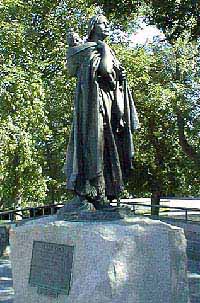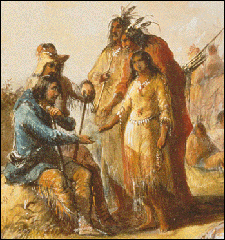
1804: The
Expedition
1812: Death
1884: Death
Revisited
1932: The Debate Begins
1996: Sudden
Popularity
1998: Sacagawea as a Symbol

Lewis and Clark seem to
have
appreciated all the work that Sacagawea did, especially
one day when the boat Sacagawea was in
flipped
over and Sacagawea was able to save some of
the papers and important items that went
overboard.
Ambrose writes
“All this time,
Sacagawea was
calm, collected, and invaluable. As
Lewis put it the
following
day, ‘The Indian woman to whom I
ascribe equal
fortitude
and resolution, with any person on board at
the time of the
accedent,
caught and preserved most of the light
articles which
were
washed overboard.’ Whether he praised her, or
upbraided her
husband,
he did not say.” (Ambrose 225).
If Lewis was to describe Sacagawea as
someone
with “fortitude and resolution,” it is
probable that he usually treated her with
respect.
It is unclear how Lewis and Clark treated
Sacagawea on a regular basis. Did
they
ignore her, treat her as a slave, or did they treat her with
respect, sensitivity, and kindness? On one
occasion
when Charbonneau began to beat
Sacagawea, Lewis and Clark stepped in to
stop.
This action shows a desire on their part to
protect her, as well as their need to keep
their
men in line.
“One wonders too how
the man
who could be so observant about so many things,
including the
feelings
and point of view of his men, could be so unobservant and
Sacagawea’s
situation.
A slave, one of only two in the party, she was also the
only Indian, the
only
mother, the only woman, the only teen-aged person.
Small
wonder she kept
such
a tight grip on her emotions” (260).
Ambrose suggests that Lewis was
“unobservant,”
possibly ignoring the sensitivity of
Sacagawea’s situation. Did Sacagawea
keep
a “tight grip on her emotions” because she need to
protect herself and her baby? Was she
constantly
making sure she was safe? The contradicitons
and inconsistences in the journals
distract from
the real picture of Sacagawea at the same time
that they give insight into her
personality.
Even though the journals is a primary source, they are
certainly not objective; if they were,
then there
would be no “mystery of Sacagawea” today.
On August 14th 1806, the Corps
returned
to the place where they first found Sacagawea.
Sacagawea, Charbonneau, and their son
stayed
behind as Lewis and Clark returned to St. Louis
and the East. Charbonneau was given
$500.33
and 320 acres of land, whereas Sacagawea was
given nothing except the experience of the
trip
and of seeing the Pacific Ocean. What did
Sacagawea sacrifice to go on that
expedition?
Was she adequately rewarded for her efforts?
Beyond Lewis and Clark’s
formal documentation
of Sacagawea’s life for the year and
half they were together, there exists
nothing
else to prove what Sacagawea did for the rest of her
life. There are two main version of
what
happened to her, and the date of her death is dependent
of what must have transpired. Why has
Sacagawea
become such a popular character with such
great significance when the only part of
her
life that was documented was the year and a half
that she spent with Lewis and Clark? There
is
little that we know about her life after she left the
Corps.
There are two main theories about
what
could have happened to Sacagawea, a Shoshoni
legend, and another. One, which is mostly
widely
held today, says that Sacagawea died after
giving birth to a daughter in 1812 at the
age
of 25 at Fort Manuel, a fur trading outpost in South
Dakota (Howard).The other version of
Sacagawea’s
life is one that many people believed for
years because it was the version passed
down
in Shoshoni oral history. In her book, Sacajawea,
Grace Raymond Hebard contends that she met
and
has proof for the theory that Sacagawea had
moved with Charbonneau, their two sons,
and Charbonneau’s
new wife, Eagle, to a reservation.
The story goes that Sacagawea died in
1884, not
1812; the reason people think she died in 1812
was because Charbonneau’s other wife died,
and
their identities were mixed up. The clerk at
Fort Manuel wrote on December 20, 1812,
“This
evening the wife of Charbonneau, a snake
squaw, died of a putrid fever. She
was
a good and the best woman in the fort, aged about 25
years. She left a fine infant girl” (qtd.
in
Hebard 160). The two competing versions of
Sacagawea’s death work to continue the
mystery
and the intrigue that comes from the fact that
so much of her character is unknown.
Sacagawea
dying in 1812 is not as much of a “fun” story.
If Sacagawea died at an old age, there is
much
more to her life than anyone can ever know.
Living to an old age makes Sacagawea live
longer
in the minds of Americans, sort of making her
immortal.

Her name: Spelling and Pronunciation
Part of the difficulty
that
allowed the debate to go on over Sacagawea is the many names
she had during her lifetime, because of
her moving
about the country from tribe to tribe, and her
Indian heritage and the tradition of
Indian names.
The difficulty people had in pronouncing and
spelling her name contributed to the
confusion
surrounding the date of her death. Throughout
the journals, Lewis and Clark spelled
Sacagawea’s
name with a “g,” taking her name to mean
“bird woman” in Shoshone. But the woman
who claimed
to be Sacagawea spelled her name
“Sacajawea” which means “boat
launcher.”
|
|
|
| Sacagawea | Bird woman |
| Sacajawea | boat launcher |
| Wadze-wipe | Lost woman |
| Bah-ribo | Guide of White river men |
| Pohe-nine | Grass Maiden |
| Bazil’s mother of Bazil Umba | |
| Porivo | Chief |
| A-va-je-me-ar | Went-a-long-way |
| Nyah Suwite | constant lover |
| Yanb-he-be-joe | the Old Comanche woman |
| Lewis and Clark spelled
Sacagawea's
names inconsistently.
Some of their spellings and references: Sah-kah-gar-we-a, Sah-ca-gee-we-ah,
Sah-car-gar-weah,
Sacarjawea, and Sacajawea.
|
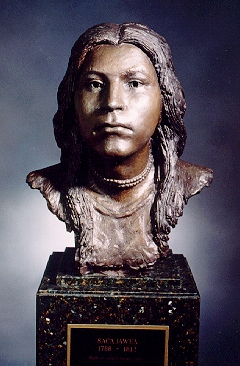
Some historians contend that it is improbable that Sacagawea thought about the importance of the voyage she was on, or her part in it. The legend of Sacagawea continues today, with historian Steven Ambrose’s book about Lewis and Clark’s expedition, Undaunted Courage, reaching the number one spot of the New York Times Bestseller list. (Women's Wire). This book portrays Sacagawea as an important character, but Lewis and Clark as the two mastermind-explorer-soldiers behind the expedition. Ambrose suggests the expedition was a great adventure. A recent PBS Ken Burns documentary also created new found interest in Lewis and Clark and Sacagawea. Two totally different forms of media, both attacking the same subject. Why did the public snatch these two versions of the expedition up? Americans love adventures full of scary challenges and great heroes who had a a hand in creating America. Not everyone always needs or wants to look at the primary sources or find out the real events. A mystery, a myth, and a legend are the stuff of which fun is made.
A committee, headed by the Secretary of the
treasury
Robert Rubin, was searching for an
American woman to replace Susan B. Anthony
on
the dollar coin. They chose an image
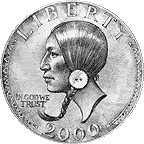 “inspired
by” Sacagawea, since there are no pictures of what she really looked
like.
They see her
“inspired
by” Sacagawea, since there are no pictures of what she really looked
like.
They see her
as a symbol of liberty that can represent
courageous
American women. When asked to explain
their decision, Philip Diehl, the
chairman, said,
“She was simply a woman of exemplary physical courage and stamina,
who 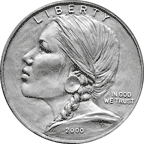
through a
remarkable
confluence of circumstances contributed to the success of
one of the
greatest
American adventures. . . She has heroism and the element of
tragedy. She was
reclaimed
from history for our generation” (Women’s Wire).
Americans may have “reclaimed”
Sacagawea,
but they have reclaimed from her story what they
wanted to. A majority of people wish
to
see her as a representative American Indian woman
who did much for the nation; they continue
her
legacy by holding her up as a symbol, and this
 symbol
is made “better” by the debate that people can still have about her
life.
Diehl’s quote
symbol
is made “better” by the debate that people can still have about her
life.
Diehl’s quote
represents what most Americans probably
think
of Sacagawea. Sacagawea was a slave who was
not even thought of as a real American.
She was
accidentally involved in the expedition, and
Americans know very little about her.
Despite
all these realities that could be considered to go
against Sacagawea being any sort of
politically
correct legend, she has become a sort of romantic
symbol of American women. This could
be
attributed to the few women in the 19th century who
are known by people today. When Americans
find
one woman who was part of something great,
they grab her and hold her up for all to
see.
It is important not to say that Sacagawea was the
heroine of the expedition at the same time
we
cannot say she did not aide them at all.
Sacagawea was not the most important
member of
the Corps, but her presence was valuable to 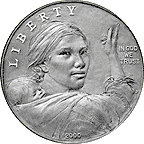
Lewis and Clark, the Corps, and therefore,
America.
Newsweek,
a weekly popular periodical, mentions Sacagawea’s upcoming
appearance on
the dollar coin, responding with,
“You
can only wonder. What might the Christian right have to
say upon learning that the plucky teen was
an
unwed mother who schlepped her baby and lover
along with her? Next to that, the yelps
over
the new $20 will seem like petty change”
(Newsweek). The authors are already
anticipating
controversy over Sacagawea, or at least some
light-humored discussion. This
controversy
is the modern day world, imposing itself and its
morals on history. How will this predicted
controversy
compare to the debates and controversy
that has always plagued Sacagawea’s
legend?
.
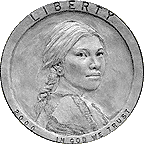 Sacagawea can be a role model for women because she was a wife and a
mother
at the
Sacagawea can be a role model for women because she was a wife and a
mother
at the
same time as she was working hard for what
was
the best for the expedition. She must have had
an incredible amount of strength to carry
her
baby on her back while gathering food, walking
nearly across a continent, and acting as a
sort
of “ambassadress” to all the Indian nations.
(Possible
Coin Designs courtesy of the U.S. Mint)
What is Sacagawea's legacy?
It is a legacy that is still changing as we
look
at what she actually did and what she is supposed to have done.
“Americans
are sentimental about their heroines. More memorials honor Sacajawea
than
any other American woman” (Howard,
vii).
Regardless of the actual facts that suggest
Sacagawea significantly helped Lewis and
Clark,
her legend continues because people want it to.
She has been “reclaimed from history,” and
that
reclaimed person is not necessarily the same
one that actually existed.
